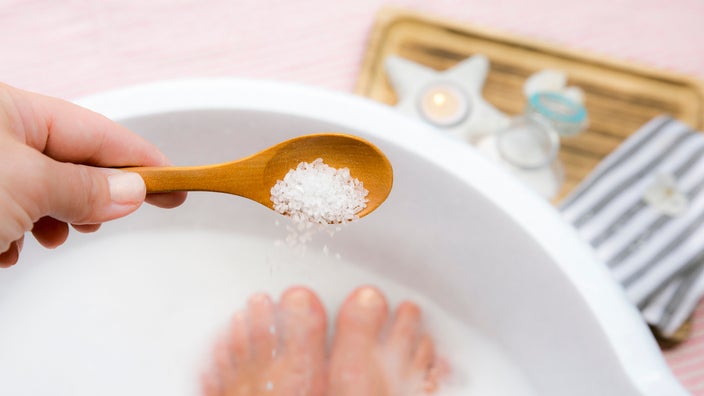
What Are the Benefits of Epsom Salt Baths?
Key takeaways:
Epsom salts are a naturally occurring mineral salt that consist mainly of magnesium and sulfate.
People have used Epsom salt baths for centuries to help with muscle pain, stress, and other problems.
Magnesium supplementation is linked to reduced muscle pain and inflammation, but the benefits of bathing in Epsom salts aren’t well supported.
Table of contents

Maybe your personal trainer recommends Epsom salt baths to relieve muscle pain and swelling. Or maybe your mom swears by them to soothe dry skin. Fans of this age-old remedy believe that it works for everything from fighting insomnia to supporting digestion.
But is the key to solving these health problems really as simple as taking a warm bath? Here’s what science says about this popular health and wellness tool.
What are Epsom salts?
Epsom salts are a naturally occurring mineral that contains magnesium, sulfur, and oxygen. It was discovered more than 400 years ago in Epsom, a town in Surrey, England. Today, you can find Epsom salts at your local grocery store or pharmacy. But this isn’t the same thing as the table salt you use to season food.
Search and compare options
The mineral salt, also known as magnesium sulfate, is known for its supposed healing properties. And it’s commonly used in baths. The magnesium in Epsom salts may be responsible for the many potential benefits of Epsom salt baths.
How do Epsom salts work?
When you pour Epsom salts into a warm bath, they dissolve. Fans of Epsom salt baths believe that your skin absorbs magnesium and sulfate particles from the dissolved salt.
Your body doesn’t naturally produce magnesium, so you have to get it from external sources, such as food and supplements. And magnesium is essential for your health. It plays a role in multiple bodily processes, such as muscle and nerve function and blood pressure regulation.
Epsom salt bath benefits
There’s a long list of possible benefits of Epsom salt baths, from pain relief to detoxification. But there’s surprisingly little evidence to support many of those claims. Researchers have noted the need for more studies, because it's unclear if Epsom salts can be fully absorbed through the skin.
Let's take a closer look at what the science says about some common uses of Epsom salt baths.
Arthritis pain and swelling
The Arthritis Foundation suggests taking a warm bath to reduce joint tenderness and swelling. And heat therapy can help relieve the pain of arthritis.
Tub time: Most people know how relaxing a soak in the bath can be. Learn more about the health benefits of a warm bath.
Magnesium 101: Magnesium, one of the ingredients in Epsom salts, plays a key role in lowering pain and stress. Learn more about this important mineral.
Natural psoriatic arthritis treatments: Epsom salt baths can be helpful for psoriatic arthritis and many other joint conditions.
The foundation also points out that, in general, magnesium is important for bone and heart health. Evidence suggests that low magnesium levels may be linked to osteoarthritis. And magnesium may also play a role in pain management. In one study, researchers found that low magnesium intake was associated with more pain and less function in people with knee osteoarthritis.
But the science on Epsom salt baths is limited. Again, researchers aren’t convinced magnesium is absorbed through the skin at all. Even if it is, soaking in magnesium salts isn’t likely to be as effective as taking magnesium supplements by mouth.
Sore muscles after working out
One of the biggest claims about Epsom salts is that they can help relieve sore muscles. So it’s surprising that there’s no direct evidence that Epsom salt baths can help soothe muscle soreness from exercise. But magnesium supplementation in general may aid muscle recovery, preventing or limiting muscle aches after a workout. And taking a warm soak is a good approach to dealing with sore muscles too.
Read more like this
Explore these related articles, suggested for readers like you.
Bruises and sprains
Similarly, no research shows that Epsom salt baths heal bruises or muscle sprains. Magnesium supplementation may reduce inflammation, which helps with wound healing.
Fibromyalgia
Many people with fibromyalgia — a condition marked by widespread pain and fatigue — use Epsom salts to soothe pain and reduce stress. There’s a lack of research on the specific use of Epsom salt baths for fibromyalgia. But studies show that adding minerals like magnesium to a warm bath (called balneotherapy) may provide a pain-relieving effect for people with fibromyalgia.
Psoriasis
The National Psoriasis Foundation notes that taking Epsom salt baths has been effective for some people in relieving itching and helping ease the removal of psoriasis scales. If you use Epsom salt baths for psoriasis or other conditions that cause dry skin, make sure the water isn’t too hot.
And the American Academy of Dermatology Association recommends limiting your bath time to 15 minutes.
Stress relief
Many chronic conditions like arthritis flare up when you’re stressed. Self-care practices like taking a bath may help. Research shows that warm baths can decrease cortisol, a stress hormone.
Magnesium may lower stress levels too. That might explain why many people swear by Epsom salt baths for relaxation and stress relief. Less stress could also mean better sleep and mental health.
Do Epsom salt baths work?
The potential benefits of Epsom salt baths aren’t well documented. However, anecdotal evidence –– or firsthand accounts –– suggests that they may help with various health problems.
And it’s easy to add them to your self-care routine. Many people take Epsom salt baths if they’re experiencing:
Joint or muscle pain
Dry or itchy skin
High stress
How to take an Epsom salt bath
The Epsom Salt Council recommends pouring 1 to 2 cups of Epsom salts into your bathtub while it fills up with warm water. It suggests soaking in an Epsom salt bath for at least 10 minutes to reap the potential benefits.
But these are just recommendations. There's no official recommendation for how often you should take an Epsom salt bath.
Remember to talk to your healthcare team and listen to your body.
How long should you soak in Epsom salts
There aren’t evidence-based recommendations on how long to soak in Epsom salts. So you can likely enjoy a soak for as long as you feel comfortable. But keep in mind that soaking in a warm bath for a long time can irritate sensitive skin.
Epsom salt bath side effects
Epsom salt baths are generally safe. But you should check with your healthcare team first, especially if you have health concerns such as:
A flare-up related to eczema, psoriasis, or other skin conditions
Burns, wounds, or a skin infection
Low blood pressure, since warmer water can lower your blood pressure
Difficulting moving around, which may make it difficult to get in and out of a bathtub
Frequently asked questions
Some bath additives can leave a residue on your skin. That doesn’t seem to be the case with Epsom salts, though. But if you have sensitive skin, it’s a good idea to take a quick rinse after a bath to remove any soap that was mixed in with the water.
Yes, it’s probably fine to take an Epsom salt bath when you’re pregnant. But make sure the water isn’t too hot. Your body temperature should stay below 102.2°F when you’re pregnant. Bath water that’s a comfortable temperature is probably fine. And consider limiting your soak time to 10 minutes.
Magnesium supplementation has been linked with reduced inflammation. While Epsom salts contain magnesium, more research is needed to say how well the body can absorb it through the skin.
The bottom line
There’s not a lot of scientific evidence to support the benefits of Epsom salt baths. But there's no denying the health benefits of magnesium, a key ingredient in Epsom salts. That may explain why fans of the age-old remedy believe that it can help relieve muscle pain and swelling, dry skin, and stress. Plus, Epsom salts are generally safe, and there are proven benefits of taking warm baths. So, it may be worth a try. But talk to your healthcare team to make sure that Epsom salt baths are right for you.
Why trust our experts?



References
American Academy of Dermatology Association. (n.d.). 8 ways to stop baths and showers from worsening your psoriasis.
American Pregnancy Association. (n.d.). Hot tubs during pregnancy.
Axtell, B. (n.d.). Managing stress to live healthy with arthritis. Arthritis Foundation.
Cao, C., et al. (2021). Balneotherapy for fibromyalgia syndrome: A systematic review and meta-analysis. Journal of Clinical Medicine.
Córdova, A., et al. (2019). Impact of magnesium supplementation in muscle damage of professional cyclists competing in a stage race. Nutrients.
Epsom Salt Council. (n.d.). Why Epsom salt?
Exploring Surrey’s Past. (n.d.). Epsom.
Goto, Y., et al. (2018). Physical and mental effects of bathing: A randomized intervention study. Evidence-Based Complementary and Alternative Medicine.
Gröber, U., et al. (2017). Myth or reality—transdermal magnesium? Nutrients.
Ismail, A. A. A., et al. (2016). Magnesium: A mineral essential for health yet generally underestimated or even ignored. Journal of Nutrition and Food Sciences.
Kass, L., et al. (2017). Effect of transdermal magnesium cream on serum and urinary magnesium levels in humans: A pilot study. PLoS One.
Kim, E., et al. (2007). The effect of psychosocial stress on sleep: A review of polysomnographic evidence. Behavioral Sleep Medicine.
Kuang, X., et al. (2021). Magnesium in joint health and osteoarthritis. Nutrition Research.
Nasermoaddeli, A., et al. (2005). Balneotherapy in medicine: A review. Environmental Health and Preventative Medicine.
National Institutes of Health. (2022). Magnesium: Fact sheet for health professionals.
National Psoriasis Foundation. (2023). Over-the-counter topicals.
Pickering, G., et al. (2020). Magnesium status and stress: The vicious circle concept revisited. Nutrients.
Sayre, C. (n.d.). Heat therapy helps relax stiff joints. Arthritis Foundation.
Shin, H., et al. (2020). Magnesium and pain. Nutrients.
Shmagel, A., et al. (2018). Low magnesium intake is associated with increased knee pain in subjects with radiographic knee osteoarthritis: Data from the Osteoarthritis Initiative. Osteoarthritis and Cartilage.
Simental-Mendia, L. E., et al. (2017). Effect of magnesium supplementation on plasma C-reactive protein concentrations: A systematic review and meta-analysis of randomized controlled trials. Current Pharmaceutical Design.




























